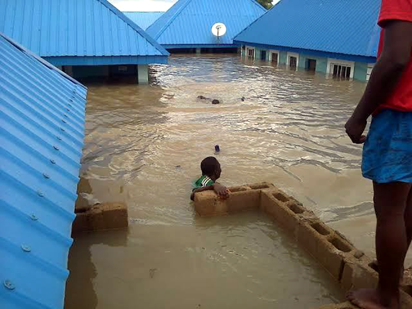
On Friday, September 7, 2018, during an emergency stakeholders’ meeting, the Director of Engineering Hydrology, Nigeria Hydrological Services Agency, Mr. Clem Nze, warned that flood was imminent and specifically noted that all the indices that played out before the 2012 flooding had all manifested. He said the decision to raise the alarm was to ensure preparedness among stakeholders and residents of flood-prone communities. Twelve states were listed to experience flooding this year due to torrential rainfalls.
Recall that in 2012, the year of flood fury, about 360 lives were lost, with over two million people displaced. Some 30 states were said to have been affected by the floods, with Adamawa, Taraba, Plateau and Benue states the worst hit by the disaster. It was estimated, according to National Emergency Management Agency, that Nigeria lost N2.6tn to the 2012 flood disaster. These numbers of the displaced and lost lives and property were those documented and recorded. The exact and specific numbers might be difficult to estimate as some cases might not have made it to the news. Would the 2012 flood disaster be said to be of a disaster foretold but ignored?
Fast forward to 2018, two government agencies, NIHSA and NEMA have raised the alarm that there was an impending flood as the downpour increased in the days ahead. NIHSA revealed that as of Friday, September7, 2018, the height of River Niger in Lokoja was 10.1 metres as against the 9.7 metres in 2012, adding that it continued to rise on an hourly basis. He added that the northern part of the country should expect more rains in the next three weeks.
A day after the timely flood alert and warning was issued by NIHSA and NEMA, we heard that in Jigawa, six people were feared dead and several others displaced. Also in Kogi, Kwara and Edo, farmlands and personal effects were destroyed. Earlier this month, Niger State recorded 14 deaths due to floods since the rain began this year. The days ahead would tell how these states and others would fare in the battle for escape from nature’s fury.
It is against this backdrop that we remind ourselves of the need to be ready for the peak of the rainy season. Put simply, flood is having too much water in the wrong place. The causes are clear. Sewage system blockage and rise in ground water level have been cited by some environmental experts as the main causes of flooding in Nigeria.
The Director-General of NEMA, Mustapha Maihaja, said, “We are causing much of the adverse weather as we fell trees in multiples but fail to replace any, and you know that trees use up our carbon dioxide and give up oxygen to breathe. The felling of trees without replacement leaves more carbon dioxide in the atmosphere which causes Ozone depletion. This simply means that the ice berg separating the sun from having direct impact on the earth causes rapid melting of the ice from above, while excess carbon dioxide from the earth also enhances rapid melting of the ice from under. Thus, there is a need for tree planting by everyone to check the continuous heavy rainfall.”
The peak of the rainy season in Nigeria is here and from experience, it comes with an attendant flooding. NIHSA, NEMA and Nigeria Metrological Agency have all raised red flag warnings for everyone to brace themselves for serious consequences advising flood-prone residents to vacate the areas.
With just a few days of rains in this peak period of rainy season, shortly after the August break, houses and farmlands have been submerged, and lives already lost to floods in some states like Jigawa and Niger. Kogi, Kwara and Edo have also been tormented by the flood menace with its sorrowful lot.
The Federal Government, in collaboration with relevant state agencies, especially states along the coastal regions, should as a matter of urgency evacuate residents of flood-prone areas and other danger zones to avert any flood devastation. The Nigerian Red Cross Society, humanitarian organisations and other relevant agencies are to be on standby to render necessary assistance to evacuated residents. The various camps where these flood-sacked victims would be staying temporarily should be provided with relief materials.
As a panacea for flooding in urban areas, government may consider building more water channels like canals, dikes and levees. Our preparedness for the peak of rainy season, effective natural disaster management and emergency response can, to a large extent, reduce the risk of flood disaster. We may not be able to prevent rains from unleashing floods, but we can mitigate adverse humanitarian effects.
Relevant agencies are duty-bound to sensitise Nigerians to how to manage disasters and flood, and be disaster-resilient. Other government agencies saddled with disaster management are urged to double down in ensuring safety of lives during emergency.
Proactive measures taken by everyone now will go a long way in getting us ready for the predicted fury of nature.
Kayode Ojewale, Idimu, Lagos kayodeojewale@gmail.com
END

Be the first to comment